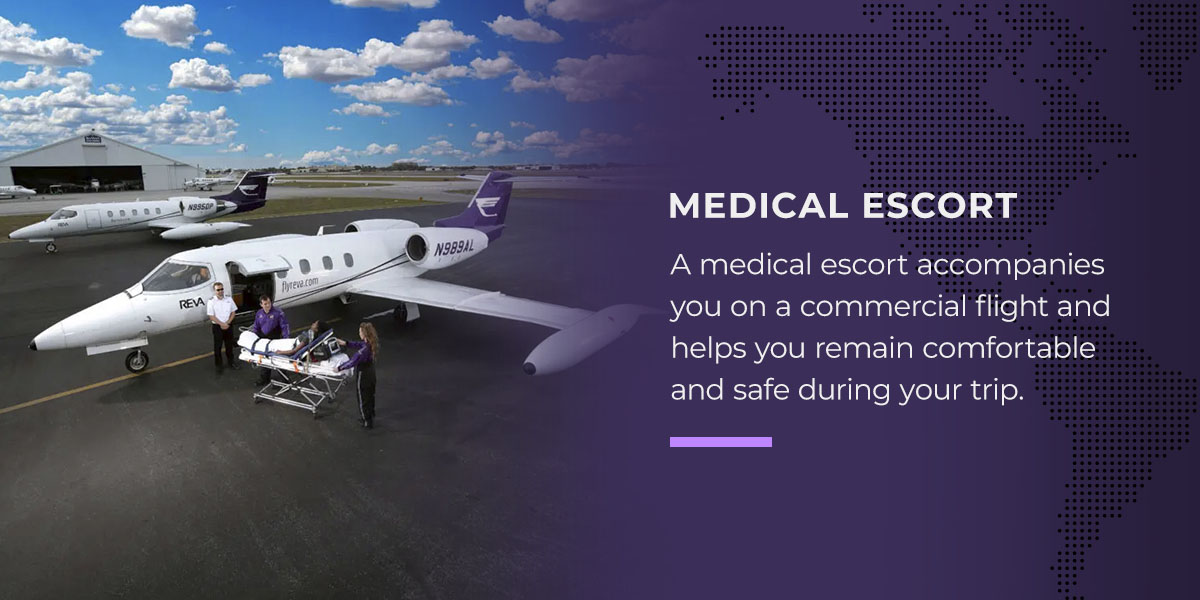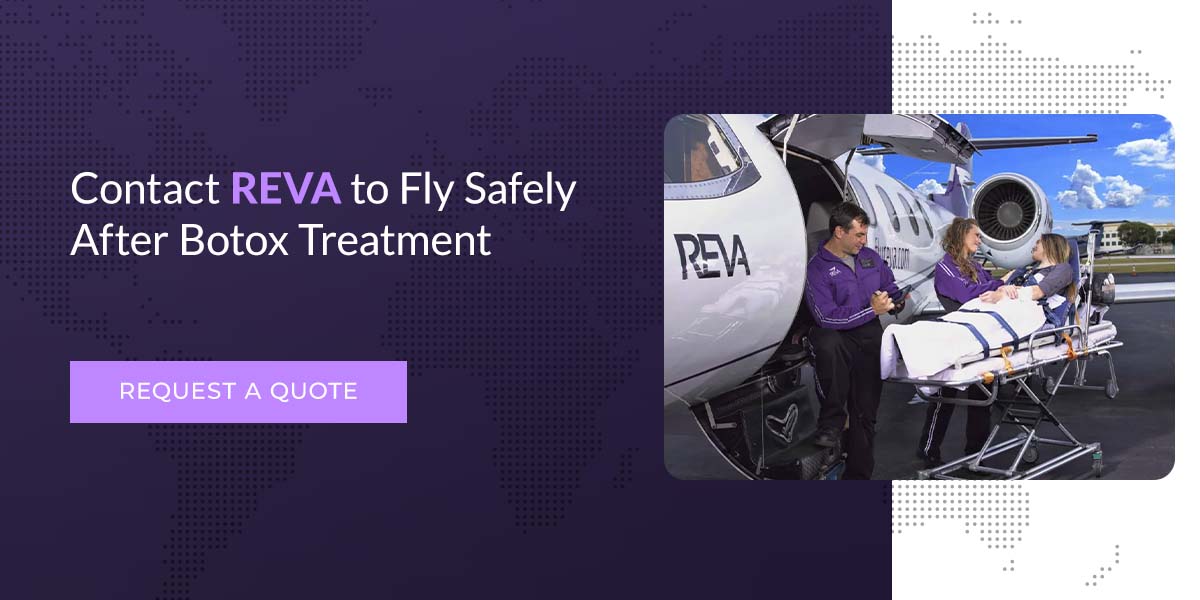Blog
STAYING ON THE FOREFRONT OF MEDICAL AIR TRANSPORTCan You Fly After Getting Botox?
You can fly after Botox if you follow your doctor’s instructions and take precautions. The safest way to travel after Botox treatment is to fly via an air ambulance or request a medical escort to accompany you on a commercial airline. Flying directly after Botox treatment can decrease its effectiveness and result in various complications, but traveling with medical support reduces these risks.
Air ambulances and medical escorts provide compassionate care, medical monitoring and emergency intervention to help you enjoy the safest, most comfortable flight possible.
Can You Fly After Getting Botox?
You can fly after botox injections, but you must take precautions. Many individuals who receive Botox injections do so regularly, which can interfere with travel plans depending on your injection dates. Understanding how to travel safely after Botox treatment can make your trip planning easier.
Speaking with your medical provider before taking a flight is essential. They can evaluate your health and determine the safest option for you. You should also understand the risks of flying after Botox to avoid complications and enjoy your trip.
How Can Flying After Botox Affect Your Body?
Understanding how Botox works is helpful when learning how flying can affect you after treatment. Botox is a neuromodulator that relaxes muscles to prevent and reduce the appearance of wrinkles or treat various conditions. This non-surgical treatment blocks the nerve signals that normally cause muscle contractions, which helps your muscles relax for purposes such as smoother skin, migraine relief, decreased neck spasms and reduced sweating.
Providers inject purified Botulinum toxin A directly into your skin during Botox treatment, and a plane’s cabin pressure changes can affect how the toxin acts in your body.
Risks of Flying After Botox
Cabin pressure changes can cause Botox to react differently in your skin, so you should be aware of the following potential risks.
Decreased Effectiveness
Pressure changes may cause Botox to spread. Providers inject Botox into specific areas based on your goals. For example, they may make injections around your mouth to reduce the appearance of laugh lines or around your eyes to prevent crow’s feet. Botox can lose its effectiveness if it spreads during your flight because it may move away from your targeted areas.
Botox Migration
Since pressure changes can cause Botox to spread, it may migrate to untreated parts of your body. Seeking medical attention immediately is essential if you experience any of the following symptoms:
- Difficulty swallowing
- Difficulty breathing
- Muscle weakness throughout the body
- Drooping brow or eyelids
- Blurred or double vision
- Loss of voice or hoarse voice
- Difficulty pronouncing words or speaking
- Loss of bladder control
Bruising, Swelling and Discomfort
Swelling and bruising are common side effects of Botox injections, and a cabin’s pressure changes can exacerbate or increase the chances of these effects. Bruising and swelling can be uncomfortable and alter your appearance, but taking precautions to fly safely can help you prevent these complications.
How Can You Fly After Botox Safely?
The safest way to fly after Botox is to travel with medical support. Having a medical professional and medical supplies available during your flight ensures you can receive care and intervention if necessary. The following options can make your trip as safe and comfortable as possible.
Air Ambulance Flight
An air ambulance is a medically equipped aircraft for individuals requiring in-flight care. On a medical flight, an experienced, compassionate medical team monitors your condition and provides medical care if necessary. You can also request a sea level flight, which flies with controlled cabin pressure to reduce pressure changes during your flight. Traveling via a sea level flight can help reduce the risk of Botox migrating in your body, which retains its effectiveness and prevents serious complications.
Medical Escort
A medical escort accompanies you on a commercial flight and helps you remain comfortable and safe during your trip. Medical escorts are highly trained to monitor health conditions, provide medical attention and respond to emergencies if necessary, making them an excellent air ambulance alternative. Flying with a medical escort can give you peace of mind as you travel, and it ensures you have support if you experience any complications.
Tips for Flying After Botox
You should also consider the following tips when flying after Botox to make your trip comfortable.
Follow Your Doctor’s Botox Aftercare Instructions
It’s easy to neglect self-care while traveling, but you should prioritize your health after receiving a cosmetic treatment. Follow your doctor’s Botox aftercare instructions, which may consist of:
- Avoiding strenuous activity for at least 24 hours or longer.
- Relaxing and maintaining a normal heart rate on the day you receive treatment.
- Not touching, rubbing or placing physical pressure on your treated area.
- Sitting up for four hours following treatment to prevent spreading and bruising.
- Performing facial exercises such as smiling, frowning and raising your eyebrows.
- Not applying makeup to the skin for at least 24 hours.
- Asking your doctor before taking medication after treatment.
Receiving Botox from a reputable, experienced doctor is also crucial. A licensed doctor uses approved ingredients and follows regulations, protecting you from counterfeit products and serious complications.
Wait at Least 24 Hours Before Flying
If you’re wondering how long to wait to fly after botox, waiting at least 24 to 48 hours can minimize risks. While this doesn’t completely eliminate risks, it allows the Botox to settle and reduces the likelihood of it moving to other parts of your body.
Flying in an air ambulance or with a medical escort is especially important if you need to fly within the first 24 to 48 hours after receiving Botox injections.
Limit Your Travels to Shorter Flights
The longer you’re on a flight, the longer you’re exposed to pressure changes. Opting for a shorter flight after receiving Botox can help reduce the risk of toxin migration, decreased effectiveness, swelling, bruising and discomfort. If you’re planning a vacation, consider choosing a destination closer to home if possible.
Contact REVA to Fly Safely After Botox Treatment
Botox treatment addresses various conditions, but it poses some risks if you fly shortly after receiving injections. REVA offers a safe way to travel after Botox treatment with air ambulance flights and medical escort services. REVA’s aircraft, medical teams and aviation teams have earned numerous safety awards, and our clients are our priority.
At REVA, we strive to provide compassion and complete care so you can travel with peace of mind. Our medical and flight teams receive ongoing training to ensure they provide the highest quality care and transportation. Contact us to request a quote and learn more about our air ambulance flights and medical escort services.



